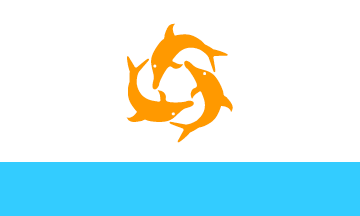
Last modified: 2006-03-18 by antonio martins
Keywords: dolphin (orange) |
Links: FOTW homepage |
search |
disclaimer and copyright |
write us |
mirrors

On 12 July 1967 Anguilla seceded from the
Associate State and adopted the white
flag with three dolphins (standing for friendship, wisdom and
strength).
Mark Sensen, 07 Jul 1996
The dolphin flag is a beautiful piece of vexillography. Stuart Notholt, 29 Sep 1996
The three dolphins are coloured orange, to represent endurance unity
and strength, and are in a circle for continuity. The flag has a white
background, for peace and tranquility, with a turquoise-blue base
representing the surrounding sea and also faith, youth and hope.
Dov Gutterman, 02 Mar 2002, quoting from
http://www.gov.ai/flag.htm
The coat of arms of Anguilla has a
bottom stripe of light tourqoise-blue.
In the flag that stripe is light blue. The reason: the Goverment of
Anguilla could not afford the money for flags with a correct shield, as
the special shade of bluish-green would have risen the costs for the
flags. So the manufacturer decided to make the shield white and blue to
keep the costs lower.
Ralf Stelter, 10 May 1999
It (the “dolphin flag”) seems to be unofficial.
Shaw [shw94] says that
Anguilla has had a design which was «unofficial...since
1967», or shortly after the U.K. forces landed.
Crampton [cra90]
simply says it was «adopted shortly after its secession
in 1967», with no word on the adopting body.
It seems to me that there is no reason why the dolphin
flag may not still be being used on Anguilla itself.
Indeed using its design in the Blue Ensign
flag badge
seems pretty much to legitimise it to me.
Yes, the dolphin flag is still used on Anguilla in
its original capacity -- unofficially. Its design was
taken as the island’s official coat of arms in 1990,
and therefore its use was legitimized on a
Blue Ensign
to form the official flag of the dependency.
Steve Kramer 27 Sep 1996
The Union Jack and the Three Dolphins flags were used for many years
[1967.09.29-1980.05.30?].
Dov Gutterman, 02 Mar 2002, quoting from
http://www.gov.ai/flag.htm
I do not think that this flag was suppressed in 1980-1990, it was
just not an official flag as far as the St Kitts-Nevis or British
authorities were concerned.
It is probably reasonable to say that the Union Jack
was the official flag on the island, but perhaps not of the
island, from 1969 until 1990 ?
David Prothero, 20 Jul 2005
I think the Anguillan status from 1969 to 1980 should be regarded as a limbo, during which Anguilla technically remained part of the Associated State of St Kitts-Nevis-Anguilla. They were all still a British colony, and the St. Kitts, Nevis and Anguilla ensign was probably the legal flag for Anguilla although I would imagine that the British did not deliberately aggravate Anguillans by flying it. The British Commissioner probably flew the UJ and may have turned a blind eye to any appearance of the Anguillan independence flag.
It was neglect from the government in St Kitts which led to Anguillan desire for separation, and from 1969 St. Kitts and Nevis institutions apparently willingly continued that neglect by dropping the name of Anguilla and any pretence of association with Anguilla. For example the St Kitts-Nevis-Anguilla Defence Force in 1969 dropped "Anguilla" from its name. But Anguilla’s status remained in limbo and governed by a series of “interim agreements” with Britain, pending formal resolution of its constitutional status.
St. Kitts, Nevis and Anguilla was granted self-government by Britain on 27 Feb. 1967 — a step towards independence. Anguilla had resented association with St K-N since the early 19th century, and took this step toward independence as an opportunity to rebel against that final fate (while they still had a perhaps more fairly minded Britain with which to negotiate rather than a sovereign government in St. Kitts and Nevis). On 30 May 1967 Anguilla evicted its police who symbolised the St Kitts government, and on 11 July they held a referendum on secession from St K-N (result: 1,813 in favor, 5 opposed). Anguilla consequently set up its own legislative council, and had in effect seceded — but the St K-N-A situation was really a stalemate.
In Dec. 1967, two British MPs worked out the first of several interim agreements whereby a British official (Tony Lee) would «exercise basic administrative authority» in conjunction with the Anguilla Council for a period of one year (January 1968 to January 1969). By the end of that period the St Kitts government and the Anguilla Council had failed to reach any agreement on their future status. Tony Lee left, and Anguilla held a second referendum. Result: 1,739 to 4 against returning to association with St Kitts. Anguilla declared itself an “Independent Republic”. The crisis was heating up, and Britain sent another envoy, William Whitlock, with proposals for another interim British administration. He was expelled within hours of his arrival in Anguilla on 11 March 1969. Eight days later, a small contingent of British paratroops landed on the island to “restore order”. The only resistance was spitting and swearing, and the paratroopers were soon followed by army engineers who embarked on public works projects to make up for all the neglect from St Kitts. Tony Lee returned as “Commissioner”. Anguillans were soon happy with their relationship with Britain, and reluctant to let the troops leave. Lee worked out another “interim agreement” in 1971, and it was not until 19 Dec. 1980 that Anguilla formally disassociated itself from St Kitts as a separate colony. And then St Kitts-Nevis became independent without Anguilla on 13 Sept. 1983.
T.F. Mills, 08 Jul 1999

The flag was manufactured in two
proportions: 1:2 for use at sea, and
3:5 for use on land.
Ralf Stelter, 27 Jun 1999